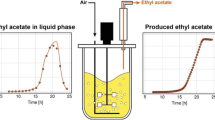Abstract.
Pilot-scale reactive-extraction technology for fully integrated L-phenylalanine (L-Phe) separation in Escherichia coli fed-batch fermentations was investigated in order to prevent an inhibition of microbial L-Phe production by-product accumulation. An optimal reactive-extraction system, consisting of an organic kerosene phase with the cation-selective carrier DEHPA (di-2-ethylhexyl phosphonic acid) and an aqueous stripping phase including sulphuric acid, was found particularly efficient. Using this system with two membrane contactors, mass-transfer coefficients of up to 288×10–7 cm s–1 for the aqueous/organic and 77×10–7 cm s–1 for the organic/stripping phase were derived from experimental data using a simple modelling approach. Concentration factors higher than 4 were achieved in the stripping phase as compared to the aqueous donor phase. Reactive extraction enabled a 98% cation portion of L-Phe in the stripping phase, leading to final product purity higher than 99% after L-Phe precipitation. A doubling of L-Phe/glucose yield was observed when kerosene/DEHPA was added to the fermentation solution in the bioreactor to experimentally simulate a fully integrated L-Phe separation process.
Similar content being viewed by others
Author information
Authors and Affiliations
Additional information
Electronic Publication
Rights and permissions
About this article
Cite this article
Maass, .D., Gerigk, .M., Kreutzer, .A. et al. Integrated L-phenylalanine separation in an E. coli fed-batch process: from laboratory to pilot scale. Bioprocess Biosyst Eng 25, 85–96 (2002). https://doi.org/10.1007/s00449-002-0279-8
Received:
Accepted:
Issue Date:
DOI: https://doi.org/10.1007/s00449-002-0279-8




